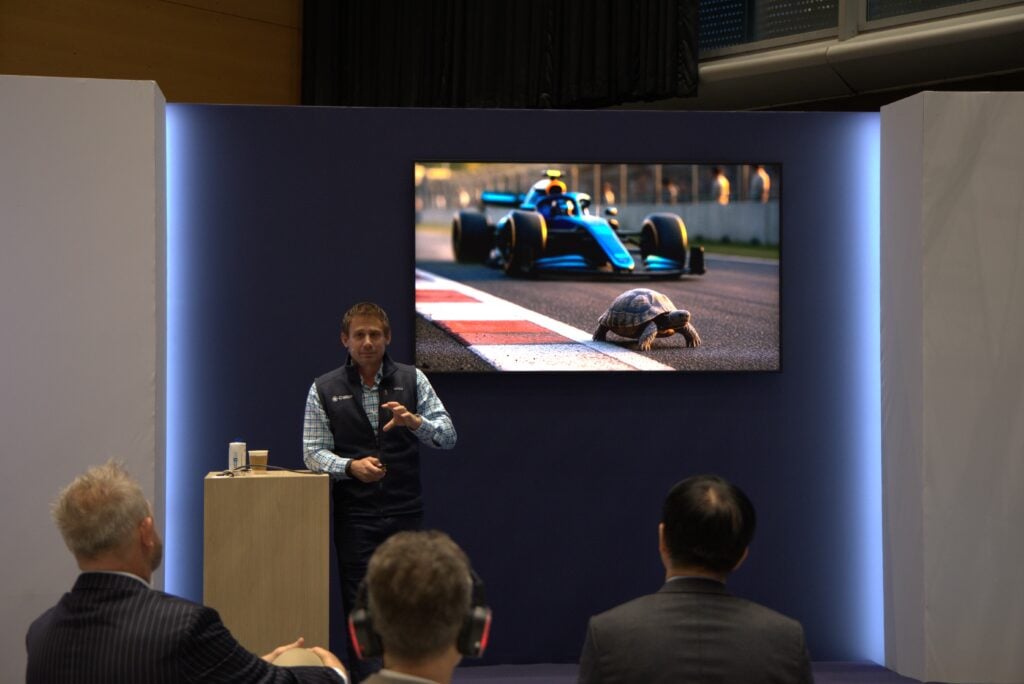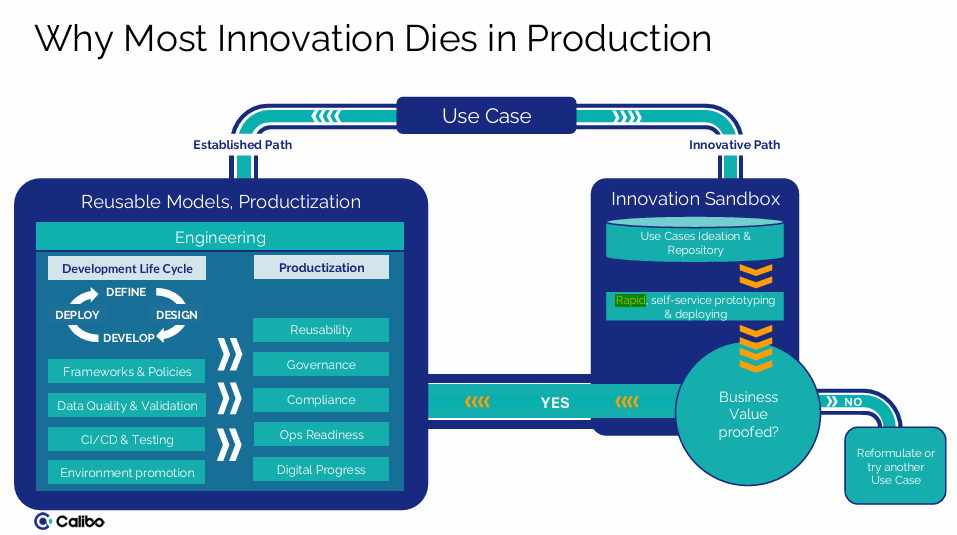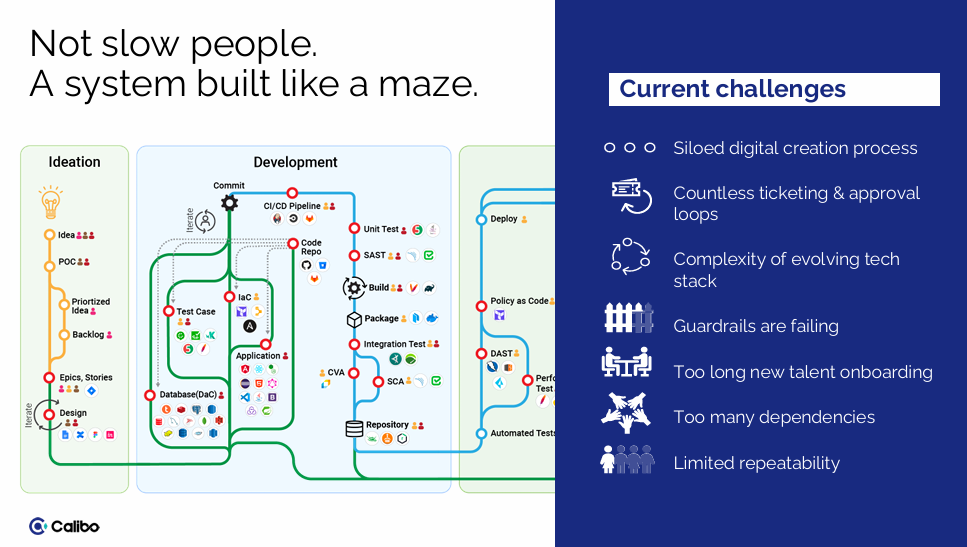

Summary
Enterprises often blame sluggish innovation on a lack of agility or slow processes. But as Scott Sandschafer, CEO of Calibo, highlighted at the Gartner IT Symposium 2025 in Barcelona, the issue isn’t speed—it’s complexity hiding in plain sight.
From disconnected systems and endless approval loops to siloed developer workflows, IT organizations struggle to move from idea to impact efficiently. Scott shared why modern CIOs need to rethink how innovation happens, replacing manual, ticket-driven systems with structured methodologies, innovation sandboxes, and end-to-end orchestration.
By redefining innovation as an orchestrated, secure, and business-aligned process, CIOs can reclaim their role as value creators rather than gatekeepers; empowering teams to move fast, safely, and at scale.
The CIO’s Challenge: “We Were Just Too Busy Optimizing”
In his keynote, Scott reflected on his time as Global CIO at Novartis, recalling how teams wanted to innovate but lacked access to the right data, tools, and environments.
As Scott says,
“The business wanted to innovate, but they didn’t have access to the tools and data in IT. We were just too busy trying to optimize and reduce costs.”
Without a defined methodology, every innovation effort became an ad-hoc exercise, slowing execution, and limiting business impact. Even large-scale initiatives, like an AI-driven procurement cost optimization pilot, stumbled due to missing governance and clarity.
“We spent $6 million on an innovation project that died under its own weight,” Scott said. “If we had a framework for where to innovate and how to prioritize, the outcome could have been very different.”
How Do CIOs Pick Smarter Innovation Bets?
Drawing from his experience at Chrysler and Novartis, Scott emphasized that IT must choose where to innovate more strategically.
According to Calibo’s innovation framework, CIOs should evaluate opportunities against six criteria:
- Strategic alignment with business goals and OKRs
- Quantified business value (ROI, KPIs)
- Feasibility based on data readiness and integration potential
- Risk and regulatory constraints
- Effort and complexity
- Confidence in success likelihood
Start in “green zones”—analytics, AI, and commercial applications—where experimentation is faster, and compliance friction is low. Avoid “red zones” like manufacturing or regulated systems as initial targets.
Empowering Teams with Autonomy—Not Just Titles
True innovation demands freedom with guardrails. Too often, business teams lose momentum navigating IT’s compliance and approval cycles.
“People get excited about an idea, but if you can’t give them an environment or access to data, the idea dies. By the time you’re ready, it’s already stale,” Scott explained.
That’s where the Innovation Sandbox comes in—a controlled, secure, and self-service environment where both IT and business can co-create.
An innovation sandbox includes:
- Preconfigured tech stacks and data access
- Embedded security and policy automation
- AI, analytics, and software development toolkits
- Integrated FinOps and cost governance
- Templates for approvals, documentation, and orchestration
It’s more than an AWS instance—it’s a digital lab designed to accelerate experimentation while keeping compliance and governance intact.
Why Most Innovation Dies in Production
As Scott explained, many innovation efforts fail because they attempt to evolve within production systems—environments burdened by legacy controls, change management bottlenecks, and manual oversight.

Innovation should flow through a rapid, self-service sandbox for proof-of-value, before moving into reusable, governed production pipelines.
This shift separates experimentation from execution, reducing risk and enabling faster iteration. Once validated, successful innovations can transition into full-scale production environments with automated compliance, CI/CD testing, and governance orchestration.
Scale What Works: The Power of Orchestration
“When I was at Novartis, we were always too slow—but I didn’t realize why. It wasn’t about speed. It was the complexity sitting right in front of us,” Scott reflected.
Modern software and data solutions rely on 10–15 different technologies. Developers and data scientists spend more time requesting access and navigating ticket-based workflows than building value.

This system shows how fragmented toolchains, manual steps, and failing guardrails stall innovation.
Calibo’s approach automates the entire lifecycle—from idea to deployment—with end-to-end orchestration:
- Capture business goals and value hypotheses
- Establish governance and security guardrails
- Preconfigure tech stacks and templates
- Build and test in sandboxes with CI/CD pipelines
- Automate security, compliance, and deployment
- Track ROI, KPIs and adoption post-launch
This orchestration eliminates friction, reduces dependency loops, and delivers faster time-to-value, without compromising compliance.
CIO Takeaways: How to Accelerate Innovation in 2026
Calibo’s methodology, shared at the Symposium, outlines three key actions for CIOs ready to close the innovation gap:
- Pick Smarter Choices: Use clear, business-aligned criteria to prioritize innovation bets. Start in the green zone—AI, analytics, and digital apps.
- Empower Teams with Autonomy: Provide innovation sandboxes that combine flexibility with governance—security, templates, and data access baked in.
- Scale What Works Through Orchestration: Automate end-to-end processes, unify CI/CD pipelines, and integrate compliance as code to enable true speed and scale.

The Real Problem Isn’t Speed—It’s Complexity
Scott closed his talk with a simple yet powerful message:
“The real problem isn’t speed. It’s complexity hiding in plain sight.”
By facing that complexity head-on—through smarter prioritization, structured innovation environments, and orchestration—CIOs can finally deliver the agility their businesses expect, without losing control.
Find out more about Calibo here.
FAQ
Why is IT seen as too slow to innovate?
IT is too slow because innovation efforts are often trapped in legacy systems, manual approvals, and fragmented toolchains that make experimentation difficult.
What’s an innovation sandbox?
A secure, preconfigured environment that allows teams to rapidly prototype and test ideas with access to approved data and tools—without affecting production systems.
How does orchestration accelerate innovation?
By automating governance, infrastructure provisioning, CI/CD, and security, orchestration removes manual bottlenecks and allows validated ideas to scale faster.
Trending articles

Data orchestration: why modern enterprises need a data orchestration platform
Data is pouring in from myriad sources—cloud applications, IoT sensors, customer interactions, legacy databases—yet without proper coordination, much of it remains untapped potential. This is where data orchestration comes in.

How Enterprise Architects can get more support for technology led innovation
Enterprise Architects are increasingly vital as guides for technology-led innovation, but they often struggle with obstacles like siloed teams, misaligned priorities, outdated governance, and unclear strategic value. The blog outlines six core challenges—stakeholder engagement, tool selection, IT-business integration, security compliance, operational balance, and sustaining innovation—and offers a proactive roadmap: embrace a “fail fast, learn fast” mindset; align product roadmaps with enterprise architecture; build shared, modular platforms; and adopt agile governance supported by orchestration tooling.

Why combine an Internal Developer Portal and a Data Fabric Studio?
Discover how to combine Internal Developer Portal and Data Fabric for enhanced efficiency in software development and data engineering.

The differences between data mesh vs data fabric
Explore the differences of data mesh data fabric and discover how these concepts shape the evolving tech landscape.

More from Calibo
One platform, whether you’re in data or digital.
Find out more about our end-to-end enterprise solution.